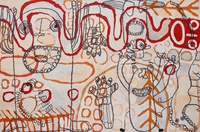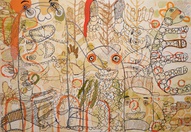Kunmanara (Tiger) Yaltangki
Indulkana, South Australia
2017
Displayed 2017 at Art Gallery of New South Wales

Kunmanara (Tiger) Yaltangki
Born 1973, Indulkana, South Australia. Lives and works Indulkana
Pitjantjatjara, Southern Desert region
Kunmanara (Tiger) Yaltangki has painted at Iwantja Arts for many years. Yaltangki’s canvases are brash and boldly coloured. They include elements of fantasy confidently represented alongside interpretations of Anangu culture and understanding of Country. His creative talent and sense of humour are also reflected in the daily application of paint to his iconic akubra hat. Yaltangki’s paintings often portray stories about contemporary life in the Indulkana community, and his artworks continue to be influenced by memories of family holidays, music by AC/DC and Hank Williams, and a love for science-fiction films and television programs.
Artist text
by Bruce McLean
Every now and then the Australian art world is reminded that it knows very little about the desert.
Tiger Yaltangki is a standout among a group of artists who are walking their own path in the desert. Based at Indulkana in the Anangu Pitjantjatjara Yankunytjatjara Lands of northern South Australia, his contemporaries at Iwantja Arts include other highly idiosyncratic artists such as Vincent Namatjira, the great-grandson of Albert Namatjira, who paints vignettes of figures of political–historical importance including his great-grandfather; Kaylene Whiskey, whose paintings of heroes and superheroes might feature Cathy Freeman chasing emus across the desert, Michael Jackson throwing boomerangs or a black Wonder Woman proclaiming ‘I will show you how great I am!’; and David Frank, a retired police officer who paints community members and policemen in all sorts of gymnastic and precarious positions, illustrating the highly elastic feat of policing within one’s own tiny community. It is among such a diverse group of vibrant artist–storytellers, and with great support from the senior cultural leaders and artists of Indulkana in Peter Mungkuri and Alec Baker, that a vision of community life so opposed to what we think we know can be produced by a shy and unassuming man like Yaltangki.
Yaltangki’s paintings are a cosmological fusion, a personal universe where diverse cultural influences and icons come together as equals. A fan of the science-fiction series Dr Who, Star Wars and the British mod-pop comedy The Mighty Boosh, Yaltangki places their fictional casts into his compositions, often alongside Mamu (spirit people, creatures or monsters) from the desert. Yaltangki titles many of his paintings Malpa Wiru (Good Friends), casting these fictional and cultural heroes at once as akin to spirit beings and as his mates. Both stylistically and compositionally, his works show influences of The Mighty Boosh; the toothy grinning faces of Noel Fielding’s paintings that spin across screen during scene breaks and their often surreal, almost absurdist staccato delivery are immediately brought to mind in Yaltangki’s paintings.
At the Desert Mob Symposium in September 2016 the Iwantja artists presented a group of ‘video portraits’, biographies of the artists combining live-action and animation that saw their paintings come to life. Yaltangki’s featured the artist walking down the street of Indulkana in his trademark painted cowboy hat and metal-band shirt as teenagers rode by on bikes and friends nodded hello, their heads morphing into the exaggerated science-fiction players from his paintings. Over a soundtrack of desert metal, a vision of Yaltangki’s world materialised, his paintings living, breathing and forming the ethnosphere around him.
The most stirring aspect of Yaltangki’s works is that while his paintings are unique, his experience isn’t. There are many thousands of Aboriginal people here, and people of specific cultures throughout the world, who are at once strong with their culture yet break the mould, constantly redefining through the course of living who and what a person of that culture should be. Yaltangki’s surreal paintings are a celebration of the richness and complexity of contemporary Indigeneity and confound and expand what we think we know about life, culture and art in the desert.



